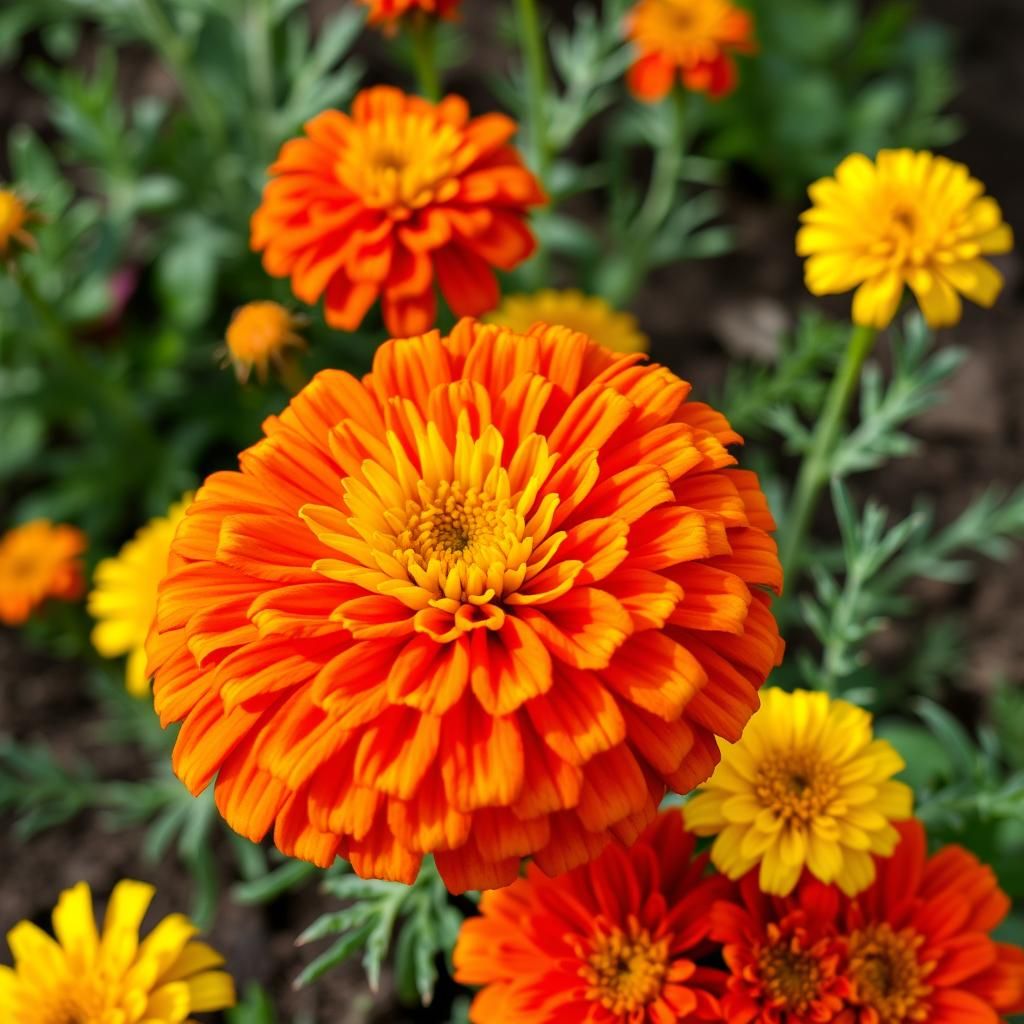Do You Deadhead Marigolds? Essential Tips for Thriving Marigold Plants

Deadheading marigolds is a crucial practice for any gardener looking to cultivate vibrant and thriving plants. This simple technique not only enhances the aesthetic appeal of your garden but also encourages healthier blooms and prolonged flowering periods. By removing spent flowers, you redirect the plant's energy towards new growth, ensuring a more robust and colorful display. In this article, we will explore essential tips and methods for properly deadheading marigolds, helping you to maximize their potential and enjoy a flourishing garden throughout the growing season. Whether you're a novice or an experienced gardener, these insights will boost your marigold care routine.
Why You Should Deadhead Marigolds
Deadheading marigolds is an important gardening practice that involves removing spent flowers to encourage more blooms and maintain the plant's health. By eliminating these faded flowers, you prevent the plant from diverting energy into seed production, instead allowing it to focus on creating vibrant new blossoms. This simple task not only enhances the aesthetic appeal of your garden but also extends the blooming period of marigolds, ensuring a more colorful display throughout the growing season. Additionally, regular deadheading can promote bushier growth and improve air circulation around the plant, reducing the risk of diseases.
What Does Deadheading Mean?
Deadheading refers to the process of removing the wilted or dead flowers from a plant. This practice is common in various types of flowering plants, including marigolds. By cutting off the spent blooms, gardeners can promote new flower growth and maintain a tidy appearance in the garden. The act of deadheading encourages the plant to allocate its energy toward producing more flowers rather than seeds, resulting in a more prolonged blooming period.
When is the Best Time to Deadhead Marigolds?
The best time to deadhead marigolds is during their blooming season, ideally when you notice flowers beginning to fade or die. This can typically be done throughout the warmer months, particularly in summer when the plants are most active. Checking your marigolds regularly will help you identify spent flowers promptly, allowing you to remove them as soon as they show signs of decline. Deadheading is beneficial when performed consistently, enhancing the overall vitality and flower production of the plants.
How to Deadhead Marigolds
To deadhead marigolds, use a pair of sharp, clean garden scissors or pruning shears. Begin by locating the faded flower heads at the end of the stems. Simply cut the stem just above the first set of healthy leaves or buds, which encourages new growth. Alternatively, you can pinch off the dead flowers with your fingers if they are soft enough. Dispose of the removed flowers appropriately to maintain garden cleanliness and prevent disease.
Benefits of Deadheading Marigolds
The benefits of deadheading marigolds extend beyond aesthetics. This practice helps prolong the blooming period, ensures a more fruitful display of flowers, and fosters healthier plant growth. Additionally, by keeping the plants tidy and free from spent blooms, you reduce the risk of pests and diseases that could affect the majority of your marigolds. Overall, regular deadheading leads to vibrant and robust plants.
Can You Overhead Deadhead Marigolds?
While deadheading marigolds is generally beneficial, it is possible to over-deadhead if you remove too many healthy blooms or foliage. Excessive cutting can stress the plant and inhibit natural growth processes. It is essential to strike a balance; only deadhead the spent flowers and avoid stripping the plant of healthy leaves or buds. A moderate approach will ensure that the plant maintains its health and continues to produce beautiful flowers.
| Term | Description |
|---|---|
| Deadheading | Removing wilted flowers to promote new bloom growth. |
| Blooming Season | The time period when marigolds are actively flowering. |
| Pests | Insects that may harm plants, potentially attracted to dead flowers. |
| Healthy Growth | Encouraging the plant to thrive under optimal conditions. |
| Bushier Growth | A result of consistent care and deadheading, leading to denser foliage. |
How often should you deadhead marigolds?

Deadheading marigolds is an essential gardening practice that can significantly influence the overall health and appearance of the plants. Ideally, you should deadhead marigolds on a regular basis, specifically once every two weeks during the growing season. This routine helps promote more blooms and prevents the plant from putting energy into producing seeds. If you notice the flowers wilting or browning, it's a good cue to perform deadheading. Regular deadheading encourages prolonged blooming and keeps the marigolds looking fresh throughout their blooming period.
Benefits of Deadheading Marigolds
Deadheading marigolds provides several benefits that can enhance both the appearance and health of the plants:
- Encourages New Blooms: When faded flowers are removed, the plant redirects its energy towards producing new buds instead of seeds.
- Improves Plant Health: Removing spent flowers decreases the risk of disease and pests that can occur with decaying plant matter.
- Enhances Aesthetic Appeal: Regular deadheading helps maintain the visual charm of marigolds, ensuring they remain vibrant and lush.
Best Time to Deadhead Marigolds
The timing of deadheading is crucial for maximizing the blooming potential of marigolds. Ideally, deadhead when:
- Flowers Begin to Fade: Look for signs of wilting or browning.
- Twice a Month: Establish a routine to deadhead every two weeks during peak growing season.
- After Rain or Wind: Weather can affect blooms, so check for damage after such events.
How to Deadhead Marigolds
The proper technique for deadheading marigolds is essential for effective results. Here’s how you can do it:
See also:
- Use Clean Tools: Ensure your scissors or pruning shears are clean to avoid spreading diseases.
- Identify Spent Flowers: Look for flowers that are wilting, browning, or falling off.
- Cut Just Above the Leaf: Make a clean cut just above the nearest set of healthy leaves to encourage new growth.
Signs Your Marigolds Need Deadheading
Knowing the signs that indicate it is time to deadhead can help keep your marigolds in top condition. Look for:
- Wilting Flowers: Flowers that appear droopy and lack vitality.
- Browning Petals: Edges or entire petals turning brown or crispy.
- Decrease in Blooming: A noticeable drop in the number of new blooms appearing.
Post-Deadheading Care for Marigolds
After deadheading, certain care practices can further support the health of your marigolds:
- Water Regularly: Ensure the soil remains moist but not waterlogged to support new growth.
- Fertilize: Consider a balanced fertilizer to provide the necessary nutrients for re-blooming.
- Monitor for Pests: Keep an eye out for any signs of pests that may harm the plants after maintenance.
How do you keep marigolds blooming?

To keep marigolds blooming, several key practices should be followed to ensure their continuous growth and vibrant flowers. By focusing on the right conditions, care, and maintenance, you can enjoy these beautiful flowers throughout their growing season. Here are some essential tips:
Optimal Light Conditions
Providing your marigolds with the right amount of sunlight is crucial for their blooming. These flowers thrive in full sun conditions, requiring at least six hours of direct sunlight each day. When plants receive inadequate sunlight, their growth can be stunted, and blooms may diminish.
- Choose a sunny location for planting.
- Avoid shading from taller plants or structures.
- Consider moving potted marigolds to maximize sunlight exposure.
Soil Quality and Drainage
Marigolds flourish in well-draining soil that is rich in nutrients. Poor soil conditions can lead to root rot and other issues that affect blooming. A good soil mix includes organic matter to promote healthy growth.
- Use a potting mix or amend garden soil with compost.
- Ensure the planting area has proper drainage to avoid waterlogging.
- Test soil pH; ideal pH for marigolds is between 6.0 and 7.0.
Watering Practices
Consistent watering is vital for marigolds to maintain their blooms. Overwatering can lead to fungal diseases, while underwatering can stress the plants and hinder blooming.
- Water deeply but less frequently to encourage root growth.
- Observe the soil moisture; it should be slightly moist but not soggy.
- Water at the base of the plant to keep foliage dry.
Fertilization Techniques
To keep your marigolds blooming, regular fertilization helps replenish nutrients in the soil. Using a balanced fertilizer can promote a vigorous blooming cycle.
- Apply a slow-release fertilizer at the start of the growing season.
- Consider using a liquid fertilizer bi-weekly to maintain nutrient levels.
- Be cautious not to over-fertilize, as this may lead to foliage growth at the expense of flowers.
Pest and Disease Management
Maintaining healthy marigolds requires vigilant monitoring for pests and diseases that can affect plant blooms. Taking early action against these threats can prevent damage.
- Regularly check for common pests, such as aphids and spider mites.
- Use insecticidal soap or neem oil when infestations are detected.
- Practice crop rotation and keep the area clean to reduce disease risk.
What happens if you don't deadhead marigolds?

If you don't deadhead marigolds, several significant changes occur that can affect the plant's health, appearance, and flower production. Deadheading is the process of removing spent flowers from the plant, and neglecting this crucial step can lead to various consequences:
1. Reduced Flowering: Without deadheading, marigolds will expend energy on producing seeds instead of generating new blooms. This can lead to fewer flowers, as the plant shifts its focus from flowering to seed production.
See also:
2. Unattractive Appearance: Dead flowers can lead to a messy and untidy look in your garden. Brown, wilted petals can detract from the overall beauty of the marigolds, making them appear neglected and lesser attractive.
3. Increased Pest Attraction: Dying flowers can attract unwanted pests. Insects like aphids or beetles may be drawn to the decaying remnants, which can lead to infestations and further harm your plants.
4. Potential for Disease: When spent flowers are left on the plant, they can become a breeding ground for molds and other pathogens. This can pose a risk to the overall health of the marigolds and may spread diseases to other nearby plants.
5. Shortened Lifespan: Neglecting to deadhead can ultimately shorten the lifespan of your marigolds. Focusing energy on seed production rather than sustaining healthy blooms can lead to earlier decline in the plant's vitality.
Reduced Flowering in Marigolds
Failing to deadhead marigolds can lead to a significant decline in flowering. The plant will begin to focus on seed production instead of generating new blooms, which consequently leads to:
- Less vibrant displays in gardens or pots.
- Fewer opportunities for pollinators to visit, which can affect other plants nearby.
- Overall diminished enjoyment of the marigold plant as its beauty fades.
Unattractive Appearance
An important aspect of gardening is the visual appeal of the plants. When marigold flowers are not deadheaded, the presence of dead blooms leads to an undesirable appearance, characterized by:
- Visible brown and wilted petals that detract from the plant's color.
- A disheveled look that can affect the overall aesthetics of the garden.
- Reduced appeal for visitors and passersby, as unkept plants can give the impression of neglect.
Increased Pest Attraction
Leaving spent blooms on marigolds can lead to increased pest problems. The decaying flowers can attract various insects, resulting in:
- Heightened risk of aphid infestations, which can damage live flowers.
- Potential for attracting beetles and other pests that can further harm your plants.
- Greater difficulty maintaining plant health due to ongoing pest management needs.
Potential for Disease
Dead flowers can create conditions favorable for diseases to develop. This can result in:
- Increased risk of mold developing around decaying matter, harming plant health.
- A greater likelihood of diseases spreading to healthy nearby plants.
- The need for additional treatments or interventions to protect plant health.
Shortened Lifespan of Plants
Neglecting to deadhead can ultimately lead to a shorter lifespan for marigolds. By focusing more on seed production, the plants may:
- Exert energy on seeds rather than maintaining vigorous blooms.
- Suffer from decreased overall vigor, leading to a decline in plant health.
- End their life cycle sooner than expected, leading to potential gaps in your garden.
Questions from Our Readers
Do you deadhead marigolds?
Yes, you should deadhead marigolds. This practice helps to promote new blooms and keeps the plants looking tidy. Removing spent flowers encourages the plant to direct its energy towards producing more flowers, rather than seed production.
When is the best time to deadhead marigolds?
The best time to deadhead marigolds is when the flowers begin to fade and turn brown. This can typically be done throughout the growing season, allowing for continuous blooming until the first frost.
How do you properly deadhead marigolds?
To properly deadhead marigolds, grasp the spent flower in your hand and gently pinch or cut the stem just above the first set of leaves. This method prevents any accidental damage to the surrounding healthy flowers.
See also:
Will deadheading marigolds attract more pests?
Deadheading marigolds will not typically attract more pests; in fact, it can help to improve plant health by removing decaying plant material that may harbor pests. Healthy plants are generally less susceptible to pest infestations.

If you want to read more articles like Do You Deadhead Marigolds? Essential Tips for Thriving Marigold Plants, we recommend you check out our Flowers category.
Leave a Reply
Related Articles